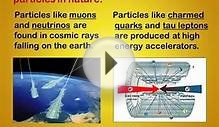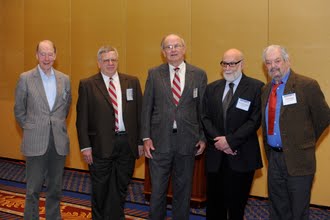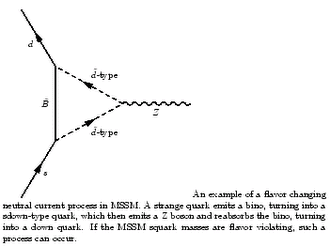
[Updated slightly, to reflect the fact that a Higgs of some type has been discovered, as announced at the LHC on July 4th, 2012.]
Most of us learned in school, or from books, that all the materials around us — everything we eat, drink and breathe, all living creatures, and the very earth itself — are made from atoms. These come in about 100 types, called “the chemical elements”, and are typically found arranged into molecules, as letters can be arranged into words. Such facts about the world we take almost for granted, but they were still hotly debated late into the 19th century. Only around 1900, when the actual size of atoms could finally be inferred from multiple lines of reasoning, and the electron, the subatomic particle that inhabits the outskirts of atoms, was discovered, did the atomic picture of the world come into focus.
But even today, some lines in this picture are still fuzzy. Puzzles dating back a century still remain unresolved. And the “Higgs boson” hullabaloo that you’ve been hearing about has everything to do with these deep questions at the heart of our own existence. Some of these blurry areas may soon become clearer, revealing details about the world that we cannot yet discern.
We learned in school that the mass of an atom comes mostly from its tiny nucleus; the electrons that form a broad cloud around the nucleus contribute less than a thousandth of an atom’s mass. But what most of us didn’t learn, unless we took a college class in physics, is that an atom’s size — the distance across it — depends mainly on the electron’s mass. If you managed somehow to decrease the mass of the electron, you’d find atoms would grow larger, and much more fragile. Reduce the electron’s mass by more than a factor of a thousand or so, and atoms would be so delicate that even the leftover heat from the Big Bang that launched our universe could break them apart. And so the very structure and survival of ordinary materials is tied to a seemingly esoteric question: why does the electron have a mass at all?
The mass of the electron, and its origin, has puzzled and troubled physicists since it was first measured. Complicating and enriching the puzzle are the many discoveries, over the past century, of other apparently elementary particles. First it was learned that light is made from particles too, called photons, that have no mass at all; then it was learned that atomic nuclei are made from particles, called quarks, that do have mass; and recently we found strong indications that neutrinos, elusive particles that stream from the sun in droves, have masses too, albeit very small ones. And so the question about the electron became subsumed in larger questions: Why do particles like electrons, quarks and neutrinos have mass, while photons do not?
In the middle of the last century, physicists learned how to write equations that predicted and described how electrons behaved. Even though they didn’t know where the electron’s mass came from, they found it easy to put the mass, by hand, into their equations, figuring that a full explanation of its origin would turn up later. But as they began to learn more about the weak nuclear force, one of the four known forces of nature, a serious problem emerged.
The physicists already knew that electric forces are related to photons, and then they realized further that the weak nuclear force is related, similarly, to so-called “W” and “Z” particles. However, the W and Z differ from the photon, in that they do have a mass — they are as massive as an atom of tin, over a hundred thousand times heavier than are electrons. Unfortunately, the physicists found they could not put masses for the W and Z particles by hand into their equations; the resulting equations gave nonsensical predictions. And when they looked at how the weak nuclear force affected electrons and quarks and neutrinos, they discovered that the old way of putting in the electron mass by hand wouldn’t work anymore; it too would break the equations.
To explain how the known elementary particles could possibly have mass at all required fresh ideas.
This conundrum emerged gradually in the late 1950s and early 1960s. Already in the early 1960s a possible solution emerged — and here we meet Peter Higgs, and the others (Brout, Englert, Guralnik, Hagen and Kibble.) They suggested what we now call the “Higgs mechanism.” Suppose, they said, there is an as yet unknown field of nature — like all fields, a sort of substance present everywhere in space — that is not zero, and uniform across all of space and time. If this field — now called the Higgs field — were of the right type, its presence would then cause the W and Z particles to develop masses, and also would allow physicists to put the electron mass back into their equations — still putting off the question of why the electron’s mass is what it is, but at least allowing equations to be written down in which the electron’s mass isn’t zero!
Over the ensuing decades the idea of the Higgs mechanism was tested in many different ways. We know, today, through exhaustive studies of the W and Z particles, among other things, that something like this is the right solution to the conundrum posed by the weak nuclear force. But the details? We don’t know them at all.
What is the Higgs field, and how should we conceive of it? It is as invisible to us, and as unnoticed by us, as air is to a child, or water to a fish; in fact even more so, because although we learn, as we grow up, to become conscious of the flow of air over our bodies, as detected by our sense of touch, none of our senses provide us with any access to the Higgs field. Not only do we lack a means to detect it with our senses, it proves impossible to detect directly with scientific instruments. So how can we hope to tell for sure that it is there? And how can we hope to learn anything about it?
There is one additional way in which the analogy between air and the Higgs field works well: if you disturb either of them, they will vibrate, forming waves. In the case of air, it’s easy to make these waves — just shout, or clap your hands — and our ears can easily detect these waves, in the form of sound. In the case of the Higgs field, it’s harder to create the waves, and harder to observe them. To make them requires a giant particle accelerator, called the Large Hadron Collider or LHC, at the CERN laboratory outside Geneva, Switzerland; and to detect them demands the use of building-sized scientific instruments, which go by the names of ATLAS and CMS.
INTERESTING VIDEO



 The Higgs boson is a hypothetical elementary particle predicted by the Standard Model (SM) of particle physics. It belongs to a class of particles known as bosons, characterized by an integer value of their spin quantum number. The Higgs field is a quantum field...
The Higgs boson is a hypothetical elementary particle predicted by the Standard Model (SM) of particle physics. It belongs to a class of particles known as bosons, characterized by an integer value of their spin quantum number. The Higgs field is a quantum field...
 The Minimal Supersymmetric Standard Model (MSSM) is the minimal extension to the Standard Model that realizes N=1 supersymmetry, although non-minimal extensions do exist. Supersymmetry pairs bosons with fermions; therefore every Standard Model particle has a partner...
The Minimal Supersymmetric Standard Model (MSSM) is the minimal extension to the Standard Model that realizes N=1 supersymmetry, although non-minimal extensions do exist. Supersymmetry pairs bosons with fermions; therefore every Standard Model particle has a partner...








